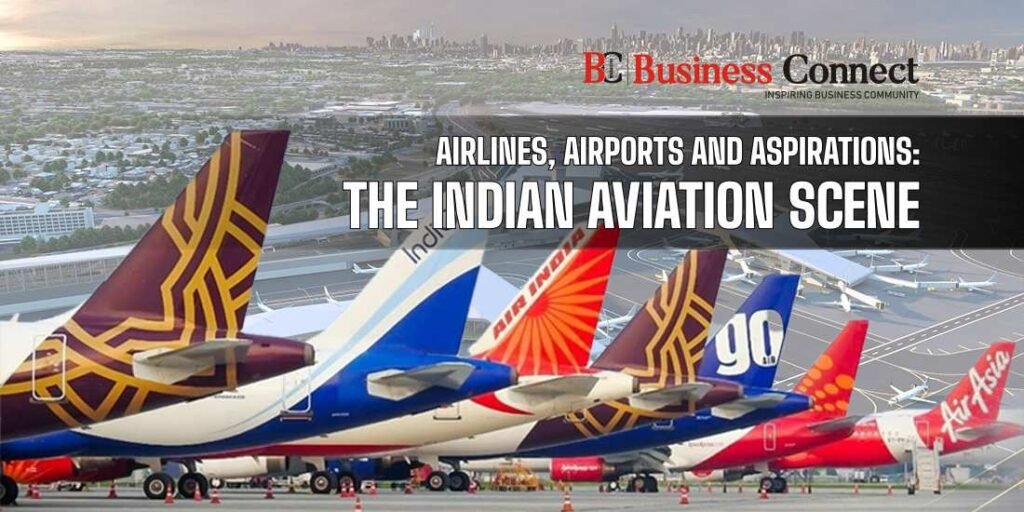Airlines, Airports and Aspirations: The Indian Aviation Scene
-by Jaya Pathak
The Aviation Industry encompasses the entire spectrum of activities related to mechanical flight and the manufacturing, operation, and maintenance of aircraft. This multifaceted sector includes a diverse range of flying machines, such as fixed-wing and rotary-wing aircraft, those with morphable wings, wing-less lifting bodies, and lighter-than-air crafts like hot air balloons and airships. The industry plays a pivotal role in facilitating global connectivity, enabling the transportation of passengers, cargo, and military assets.
Key components involve aircraft design, manufacturing, and technological advancements, ensuring safety and efficiency in air travel. The aviation industry is a dynamic and ever-evolving field, with constant innovation in aerodynamics, propulsion systems, and navigation technologies. It is a critical driver of economic growth, providing jobs, fostering international trade, and connecting people and cultures across the world.
It’s impressive to see the remarkable growth and transformation of India’s aviation industry over the past decade. The increase in the number of operational airports, government initiatives, and the liberalization of the sector have played pivotal roles. The entry of low-cost carriers and various government schemes, such as the ‘Revival of unserved and under-served airports’ and KrishiUdan 2.0, reflects a comprehensive approach to fostering growth.
The commitment shown in the Union Budget, with allocations for the Regional Connectivity Scheme (UDAN), and the significant order placed by Air India for 470 aircraft from Boeing and Airbus, underlines the industry’s positive trajectory. The focus on technology, like artificial intelligence and automation, is poised to enhance efficiency and cost-effectiveness.
With the government’s ongoing support, the Indian aviation industry is set to continue its ascent, with expectations of substantial growth in international travel and cargo.
The recent report from CAPA India provides a comprehensive overview of the current state and future projections for India’s aviation industry. The anticipated robust growth of approximately 15% in air traffic during the fiscal year 2023-24, reaching 155 million passengers, is a positive indicator of the industry’s resilience.
Despite challenges such as the unexpected grounding of Go First, the report underscores the domestic air traffic’s ability to weather disruptions. The projection for over 200 grounded aircraft by March 2024, leading to parking challenges, highlights ongoing supply chain issues affecting the aviation sector.
The growth in international air traffic aligning with CAPA’s guidance and the expected year-end figure of around 70 million passengers for international travel indicate a broader recovery in the aviation sector. The estimated overall profitability, despite the initial projection of a USD 1.648 billion loss, showcases the industry’s adaptability.
IndiGo’s anticipated record profit of USD 500 million, despite operational challenges, is a notable highlight contributing to the positive outlook for low-cost carriers. The expansion efforts of the Air India Group, adding over 60 aircraft by the end of the financial year, demonstrate a commitment to growth.
However, the report also sheds light on the operational fleet constraints, with a projected 789 aircraft on the register and only 588 expected to be operational by the year-end. Strategies such as wet leasing by airlines like IndiGo and SpiceJet to address capacity shortfalls indicate the industry’s proactive approach to overcoming challenges.
The normalization of domestic and international fares from post-pandemic highs, despite ongoing aircraft shortages, signals a gradual return to pre-pandemic market conditions. Overall, the report paints a picture of a dynamic and resilient Indian aviation industry, poised for growth despite prevailing challenges.
The surge in airplane purchases, airport expansions, and overall aviation infrastructure development in India reflects the nation’s ambitious efforts to establish itself as a major player in the global aviation landscape. The growth is not only a testament to economic progress but also a strategic move to cater to the rising aspirations of the expanding middle class.
The expansion of Indira Gandhi International Airport to accommodate 109 million passengers and the subsequent race to become the world’s second busiest airport signify India’s determination to enhance its air travel capabilities. Despite the country’s historical reliance on trains, the substantial investment in aviation is positioned as a symbol of national pride and a key driver of economic development.
While air travel remains financially inaccessible for a large portion of the population, the reported 3 percent of regular fliers still amounts to a significant 42 million people. This segment includes professionals and students seeking efficient travel within the country and improved access to international destinations for both business and leisure purposes.
Kapil Kaul’s emphasis on the next two to three years being critical for achieving profitable growth underscores the industry’s need to demonstrate financial sustainability amid the massive spending spree. The potential economic impact, including increased cargo and foreign investment, is expected to reverberate across various sectors.
The role of major airplane manufacturers like Boeing and Airbus in benefiting from India’s aviation boom is noteworthy. Large-scale orders from Air India and IndiGo demonstrate the confidence placed in India’s aviation market.
The focus on expanding airport infrastructure beyond major metropolitan areas, as highlighted by Prime Minister Narendra Modi’s government, reflects a commitment to ensuring widespread connectivity. The doubling of the number of airports in the past nine years and the projected increase to at least 230 by 2030 demonstrate a concerted effort to bring air travel accessibility to various regions of the country.
Overall, India’s aviation ambitions align with its broader economic goals, and the substantial investments and expansions in the sector are poised to shape the nation’s image and contribute significantly to its growth story.
The significance of the aviation industry is emphasized by its globalized nature, connecting people, countries, and cultures across vast distances. This interconnectedness has greatly contributed to efficient travel and has had a profound impact on various aspects of modern life.
Distinction Between Aviation Industry and Airline Industry:

Airline Industry: Specifically refers to businesses that offer air transportation services for people or cargo. It is a subset of the broader aviation industry.
Aviation Industry: Encompasses a more extensive range of entities, including aircraft manufacturers, researchers, air safety specialists, military aviation, and drone-related businesses. It provides a holistic view of the entire field beyond just passenger or cargo transport.
The global nature of the aviation industry has played a pivotal role in making travel to distant places more efficient. This has had a transformative effect on people’s lives, fostering cultural exchange, economic development, and international cooperation.
The aviation industry, with its diverse components, goes beyond just transporting people or goods. It involves cutting-edge technology, safety measures, military applications, and the evolving realm of drone technology. Understanding the intricacies of both the aviation and airline industries is crucial for appreciating their collective impact on the world.
Indian Airlines, once a government-owned carrier in India, underwent a transformation into a segment within Air India Limited before eventually discontinuing its operations. Operating from Delhi, it primarily serviced domestic routes, offering limited international flights to neighbouring Asian nations, the Middle East, and South-East Asia.
Following the merger of eight domestic airlines existing before India’s independence, Indian Airlines became a division under the umbrella of Air India Limited. This strategic integration aimed to streamline and consolidate the nation’s aviation sector. Despite its historical significance in shaping India’s aviation landscape, Indian Airlines ceased operations, marking the end of an era and highlighting the dynamic nature of the airline industry.
Airport infrastructure encompasses an extensive domain, comprising tangible structures and intangible systems. From conspicuous passenger terminals, replete with security and catering facilities, to runways, air traffic control towers, and indispensable yet concealed baggage systems, gate operations, and lighting systems, the intricate network extends to organizational frameworks involving management and financial responsibilities. The financial aspect is formidable, with the maintenance and enhancement of airport infrastructure incurring substantial costs.
According to IATA, a staggering $1.2 to $1.5 trillion is projected to be invested in infrastructure development by 2030. In 2021 alone, 159 airport projects globally commenced, with a cumulative value nearing $110 billion.
Airport Technology’s findings reveal that 59% of these projects focused on terminals, involving expansions or novel constructions, amassing over $87 billion in investment. Notably, two among the ten most expensive ventures are novel constructions in the Philippines, each exceeding a $10 billion investment. While predominantly situated in Asia, San Diego’s new terminal project secured a place on the list with a noteworthy $2.6 billion investment.
Passenger Traffic
India is poised to witness a domestic air passenger traffic of approximately 155 million in the current fiscal year, with an estimated 200 grounded aircraft from domestic carriers, according to a recent report by aviation advisory firm CAPA India. The report highlights that international air passenger traffic is anticipated to reach around 70 million by March 2024.
Although domestic air traffic has consistently surpassed levels from the pre-pandemic fiscal year 2020, the recovery momentum has slightly diminished in recent months. Conversely, international traffic has largely mirrored 2020 figures since May 2023, with expectations of a progressive upswing in the remaining months of the fiscal year.
CAPA India’s March report had initially projected domestic air passenger traffic to exceed 160 million and international air passenger traffic to range between 72-75 million. The report underscores an anticipated overall industry profitability in line with the initial forecast, predicting a USD 1.6-1.8 billion loss. Notably, despite operational challenges, IndiGo is expected to achieve a record profit of USD 500 million, strengthening its cash reserves by over USD 1.2 billion.
As of March 2024, the total operational fleet of airlines is projected to reach 588 planes, with approximately 200 expected to remain grounded, including around 90 from IndiGo. Air India and SpiceJet are projected to have 25-30 and 27 grounded planes, respectively. The report envisions a fleet register at the end of FY2024 to encompass close to 790 aircraft, reflecting a year-on-year increase of around 100, with the Air India Group accounting for more than 60 of these additions.
Aviation Safety
Aviation safety, an indispensable facet of air travel, is meticulously governed by stringent protocols and advanced technological measures. This imperative domain encompasses multifaceted systems ensuring the well-being of passengers, crew, and aircraft. Rigorous training, stringent maintenance standards, and real-time monitoring contribute to a formidable safety framework.
Aviation authorities globally collaborate to establish and uphold unified safety standards. Cutting-edge advancements in avionics, navigation, and communication enhance situational awareness, mitigating risks. This steadfast commitment to safety, coupled with continuous advancements, solidifies air travel’s status as one of the safest modes of transportation in the modern era.
Domestic Airlines
In the vibrant tapestry of India’s aviation landscape, domestic airlines play a pivotal role in connecting the diverse corners of the nation. These carriers navigate the expansive skies, linking metropolitan hubs, burgeoning cities, and remote regions, fostering economic development and cultural exchange. Given below is the list of domestic airlines in India:
- IndiGo
- SpiceJet
- Air India
- Vistara
- AirAsia India
- Air India Express (IX)
- AirAsia India
- Go First
International flights
- Air China Flights
- Air Arabia Flights
- Austrian Airlines
- British Airways
- Cathey Pacific Airlines
- Delta Airlines
- Emirates Airlines
- Etihad Airways
- Finn Air Flights
- KLM Airlines
- Kuwait Airways
- Malaysia Airlines
- Oman Airlines
- Qantas Airlines
- Qatar Airways
- Jazeera Airways
- Royal Jordanian Airlines
- Srilankan Airlines
- Thai Airlines
- Tiger Airways
Airports in India
In India, a nation of diverse landscapes and burgeoning economic activity, a network of airports serves as vital gateways, connecting regions and facilitating domestic and international travel. The aviation infrastructure in India reflects a harmonious blend of modernity and tradition, catering to the burgeoning demands of a dynamic populace. There are numerous of airports that contribute to the country’s vibrant aviation. Some of the famous Airports in India are listed below:
- Indira Gandhi International Airport, New Delhi
- Chhatrapati Shivaji Maharaj International Airport, Mumbai
- Kempegowda International Airport, Bengaluru
- Rajiv Gandhi International Airport, Hyderabad
- Chennai International Airport, Chennai
- Netaji Subhas Chandra Bose International Airport, Kolkata
- Cochin International Airport, Kochi
- Sardar Vallabhbhai Patel International Airport, Ahmedabad
- Pune International Airport
- Dabolim Airport, Goa



